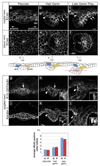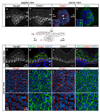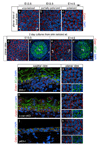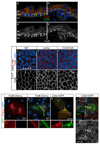Planar polarization in embryonic epidermis orchestrates global asymmetric morphogenesis of hair follicles
- PMID: 18849982
- PMCID: PMC2607065
- DOI: 10.1038/ncb1784
Planar polarization in embryonic epidermis orchestrates global asymmetric morphogenesis of hair follicles
Abstract
Mammalian body hairs align along the anterior-posterior (A-P) axis and offer a striking but poorly understood example of global cell polarization, a phenomenon known as planar cell polarity (PCP). We have discovered that during embryogenesis, marked changes in cell shape and cytoskeletal polarization occur as nascent hair follicles become anteriorly angled, morphologically polarized and molecularly compartmentalized along the A-P axis. Hair follicle initiation coincides with asymmetric redistribution of Vangl2, Celsr1 and Fzd6 within the embryonic epidermal basal layer. Moreover, loss-of-function mutations in Vangl2 and Celsr1 show that they have an essential role in hair follicle polarization and orientation, which develop in part through non-autonomous mechanisms. Vangl2 and Celsr1 are both required for their planar localization in vivo, and physically associate in a complex in vitro. Finally, we provide in vitro evidence that homotypic intracellular interactions of Celsr1 are required to recruit Vangl2 and Fzd6 to sites of cell-cell contact.
Figures








Comment in
-
Bad hair days for mouse PCP mutants.Nat Cell Biol. 2008 Nov;10(11):1251-3. doi: 10.1038/ncb1108-1251. Nat Cell Biol. 2008. PMID: 18978834 No abstract available.
References
-
- Zallen JA. Planar polarity and tissue morphogenesis. Cell. 2007;129:1051–1063. - PubMed
-
- Seifert JR, Mlodzik M. Frizzled/PCP signalling: a conserved mechanism regulating cell polarity and directed motility. Nat Rev Genet. 2007;8:126–138. - PubMed
-
- Kibar Z, et al. Ltap, a mammalian homolog of Drosophila Strabismus/Van Gogh, is altered in the mouse neural tube mutant Loop-tail. Nat Genet. 2001;28:251–255. - PubMed
-
- Curtin JA, et al. Mutation of Celsr1 disrupts planar polarity of inner ear hair cells and causes severe neural tube defects in the mouse. Curr Biol. 2003;13:1129–1133. - PubMed
Publication types
MeSH terms
Substances
Grants and funding
LinkOut - more resources
Full Text Sources
Molecular Biology Databases
Miscellaneous

